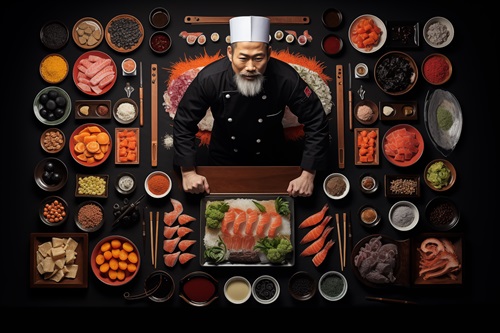In the center of a meticulously organized kitchen, a sushi chef stands as a beacon of culinary tradition and expertise. This chef, skilled in the ancient art of sushi making, is surrounded by an array of raw ingredients, each carefully placed in a precise, organized manner that echoes the principles of knolling. This setup not only highlights the aesthetic beauty of the ingredients but also reflects the chef's deep respect for order and discipline in his craft.
The Sushi Chef: A Master of Balance and Precision
Dressed in a traditional kimono and hachimaki, the sushi chef represents a blend of artist, craftsman, and culinary expert. His role is steeped in tradition, requiring years of dedicated training to master the intricate skills of sushi preparation. He is not just a cook; he is the guardian of a culinary art form that balances taste, texture, and presentation in perfect harmony.
Knolling: An Art of Organization in Sushi Cuisine
The chef's workspace is a testament to the practice of knolling - arranging items at 90-degree angles to create an organized environment. This methodical layout serves a dual purpose: it enhances the visual appeal of the ingredients and allows the chef to efficiently access everything he needs. The discipline of knolling mirrors the precision required in sushi preparation, where every detail matters.
The Ingredients: A Palette of Freshness and Quality
Surrounding the chef is a cornucopia of the finest ingredients, each chosen for its freshness and quality. Slabs of sashimi-grade fish like tuna, salmon, and eel, each with their distinct color and texture, are prominently displayed. Beside them are shelled shrimp, creamy scallops, and bright orange roe, adding to the spectrum of seafood varieties.
Vegetables and accompaniments are also part of the knolling arrangement. Crisp cucumbers, ripe avocados, and tangy pickled radishes are ready to be sliced and incorporated into the sushi. Wasabi, soy sauce, and pickled ginger are strategically placed for seasoning and garnishing, essential for the complete sushi experience.
The Chef's Role: Beyond Preparing Sushi
The chef's responsibilities extend beyond merely assembling sushi. His expertise involves understanding the unique characteristics of each ingredient. He knows precisely how to slice fish to maximize flavor and texture, and how to season and mold the sushi rice to achieve the perfect balance.
Presentation is key in sushi making, and the chef is a master of this art. He arranges each piece of sushi on the plate with an eye for aesthetics, ensuring that the final presentation is as pleasing to the eye as it is to the palate.
In Conclusion: A Symphony of Flavors and Artistry
As the chef works, there is an air of tranquility and focus that surrounds him. The knolled arrangement of his ingredients not only facilitates efficiency but also symbolizes his respect for the ingredients and the sushi-making process. Each piece of sushi he crafts is a small work of art, reflecting a balance of tradition, flavor, and meticulous attention to detail. In this space, the sushi chef continues to honor and perpetuate the revered art of sushi, one meticulously crafted piece at a time.

